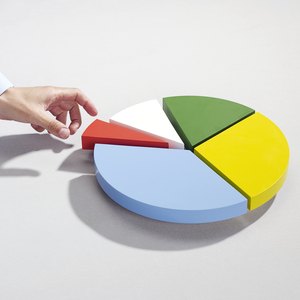
For businesses to stay competitive, they need to know their market, i.e., who is, and who is not, buying their product or service. Market share points to the size of a single market controlled by one company. Absolute market share is not a difficult percentage to come by. To do so, simply divide a company's gross sales over a month, quarter or year and then divide that by the total sales in the same industry for the same span of time.
As elementary as that sounds, absolute market value does not give executives the entire competitive picture. They should also know the relative market share.
What Is Relative Market Share?
As absolute market share measures one entity's performance against an entire industry, while relative market share makes that comparison on a company-to-company basis. Why is this important? Some industries are not always marked by high growth, meaning that the markets are not expanding robustly or consistently. The earnings pie, so to speak, for that particular commercial sector, is stagnant or even contracting.
This reality intensifies the struggle among companies vying for more of the pie. Each will need to know how sales are compared to its closest competitors. This relative market share approach is essential.
Discerning Relative Market Share
If an absolute market share example is, say, 27 percent for a given company, then its commercial rivals control 73 percent of the total market among them, no matter how many. Relative market share is determined by dividing the company's market share by the combined share occupied by the competitors. If, then, the subject business has an absolute market share of 27 percent, dividing that by 73 yields a relative market share of 37 percent, rounded off of course.
With both absolute and relative shares in hand, a company can better make strategic decisions regarding sales, advertising, hiring etc.
Measuring Change in Market Share
Figuring out market share is helpful yet it is something of a snapshot. Adopting a market share increase formula, or decrease calculation, conveys further information about a company's position relative to its competitors. Using the same sources of information, wait three months and then calculate relative market share again.
In this manner, analysts can see what direction market share is going and can learn how to capitalize on such trends. For instance, if relative market share is 32 percent in January and 29 percent in April, executives know that their rivals are doing something right.
As absolute market share measures one entity's performance against an entire industry, while relative market share makes that comparison on a company-to-company basis.
Best Sources of Market Share Information
Trade magazines and industrial associations publish statistics about market sizes and shares per company. Detailed reports are available, for a fee, on sites like Mintel and Business Source Premier. For the cost-conscious, these sources, and others like them, are often among subscriptions held by public and university libraries.
Sometimes it takes some digging but the dividends can be generous if the research leads to successful business strategies. Often, trade journals and online resources can give beneficial information beyond market shares.
How Companies Improve Their Market Share
Up-to-date and accurate knowledge can lead to change in market share for the better. It can spur company leadership to innovate technologically, organizationally or in terms of public relations. Businesses can learn from competitor success, working to solidify the bonds of customer loyalty.
In addition, market share feedback can motivate employers to recruit the highest quality staff people and retain them for years and decades, precluding the human resource headaches of high turnover. In some cases, a corporation interested in a larger market share will acquire a corporate rival.
References
Writer Bio
Adam Luehrs is a writer during the day and a voracious reader at night. He focuses mostly on finance writing and has a passion for real estate, credit card deals, and investing.

